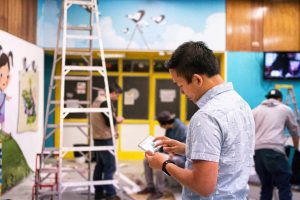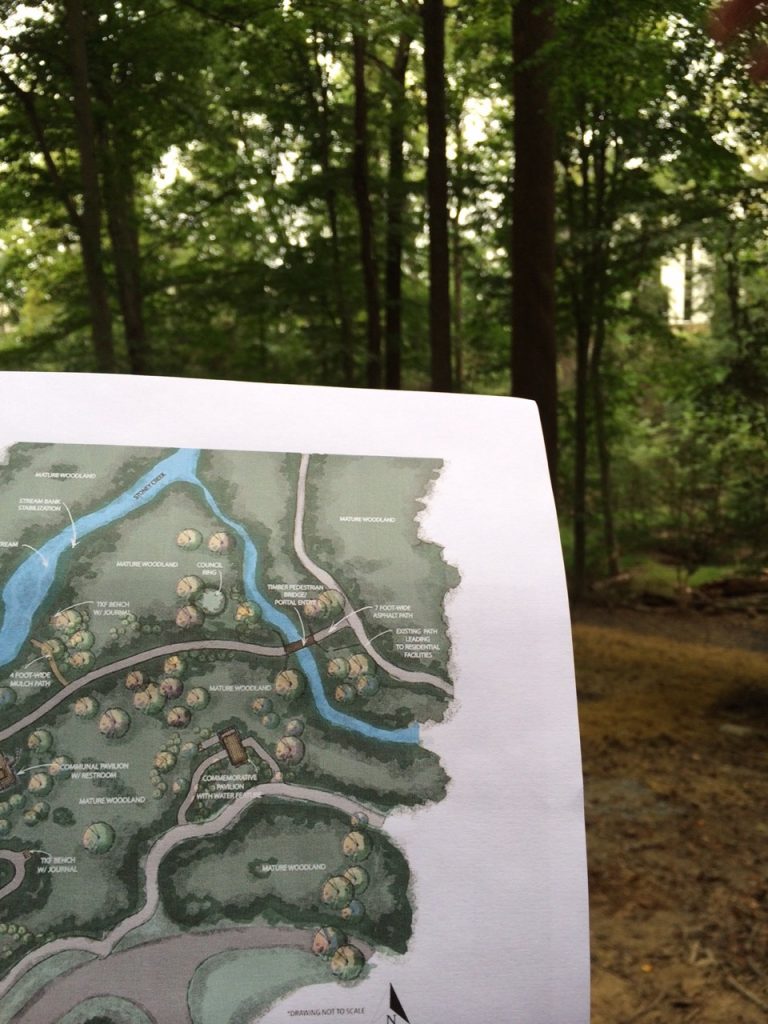Posts Tagged ‘healing spaces’
COANIQUEM – Safe Niños Part 2
On my third meeting with the students, a small core of three teams remained, each continuing the project through a second term. Each team presented their projects that had matured and were ready to take back to Chile to install. The first student, Alvin, presented the story and animal characters his team had created to help guide the children through the magic land through which they would be “flying” as they went on their healing journey. 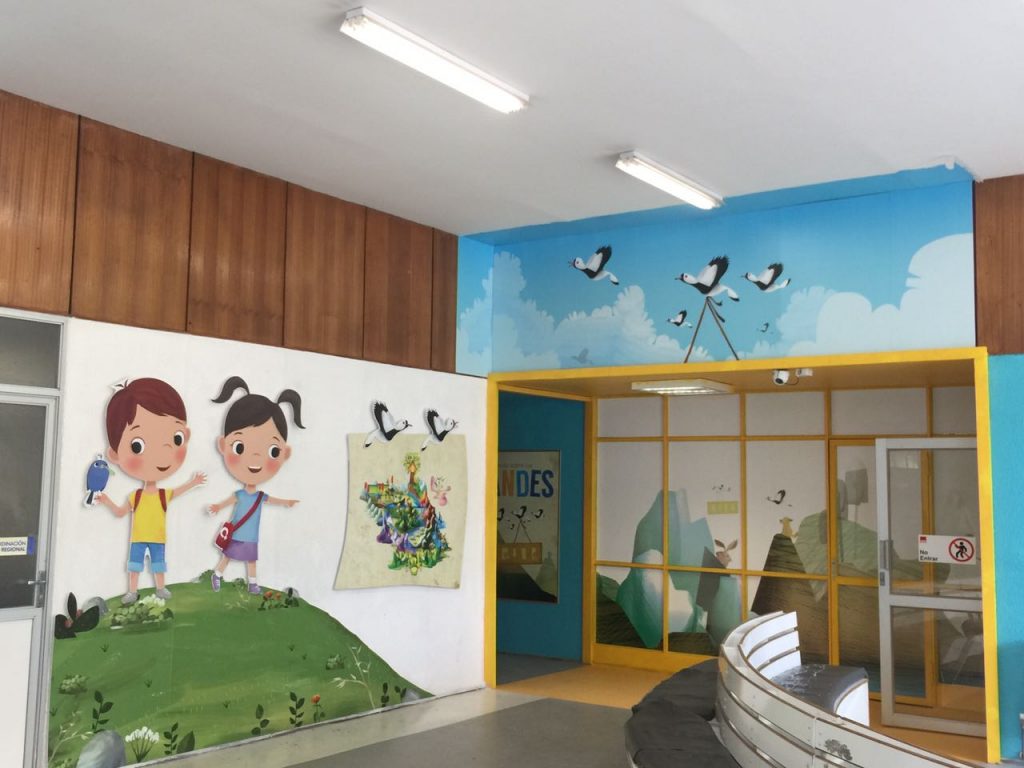 The land, complete with a colorful map that resembled a cross between Middle Earth and Candy Land, was, like Chile – long and narrow, flanked with whimsical mountains peopled by the trees and animals of Chile.
The land, complete with a colorful map that resembled a cross between Middle Earth and Candy Land, was, like Chile – long and narrow, flanked with whimsical mountains peopled by the trees and animals of Chile.  The waiting room was to be the entrance to this magical kingdom, and the doors leading to treatment rooms along the long hallways were to be decorated with charming animal characters inviting the young patients in. There was even a passport that the children and their families would receive when they arrived in the waiting room, to be stamped in every treatment room when they received their compression garments, physio- or occupational therapy.
The waiting room was to be the entrance to this magical kingdom, and the doors leading to treatment rooms along the long hallways were to be decorated with charming animal characters inviting the young patients in. There was even a passport that the children and their families would receive when they arrived in the waiting room, to be stamped in every treatment room when they received their compression garments, physio- or occupational therapy.
Then students Behnia and Anna presented their solution to motivate the teens, who had been returning to the clinic for years for multiple treatments: a “Teen Zone” flanked by mural-painted shipping containers that were already being used for storage on the site. The area would be covered with colorful sail shades and was made attractive to teens with a dance area and hammocks.
Finally, Nicholas and Dave presented their low and hi tech brightly colored “toys,” designed to help the children participate in physio- and occupational therapy treatments to increase mobility and activity, and reduce stress. The design challenge that they were solving was how to provide the therapists measureable feedback on the progress of treatment, while motiving the kids with musical and visual feedback.
It was a remarkable display, accomplished over a few short months. The passion of the students shone through. An added benefit: the project had inspired the staff, the patients, and their families with pride for COANIQUEM and its cutting edge treatments, giving them happiness and hope for healing, even before the projects were installed. Then, to top it off, one of the students – Alvin, won a grant to complete his project and fly back to Chile to install it, launching his career while doing good in the world. What better outcome could there be!
The “Green Road”: Healing wounds of war with nature. Part 2
The first sign that I was getting close to the “Green Road” was a view of a grove of trees and a flock of geese staidly crossing the street nearby. The urban noises began to fade as sounds of crickets and birds gradually replaced them. It was like the “slow fades” between lands in a Disney theme park. Soon, I was surrounded by trees as I entered an entirely new world. 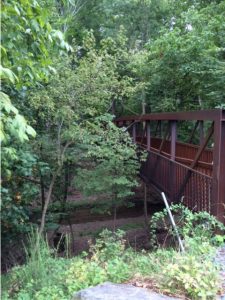 The gently sloping paved switchback path led to an old iron bridge across the Rock Creek. As I crossed the bridge over the pebbled lazy stream below, I could see deer grazing among the trees. The leaf-strewn path led to an open area where large granite rocks had been placed in a circle – inviting visitors to gather and share songs and stories. Farther on, beside the stream, was one of the signature large oak benches that the TKF Foundation places in all their gardens. There, visitors can contemplate in peace, or write their thoughts in a waterproof journal placed underneath the seat. Up on the steep hillside above the stream was a simple covered wooden structure, held by a low dry rock wall. A single large slatted wooden bench at its back, welcomed one to sit in quiet and remember loved ones lost in battle.
The gently sloping paved switchback path led to an old iron bridge across the Rock Creek. As I crossed the bridge over the pebbled lazy stream below, I could see deer grazing among the trees. The leaf-strewn path led to an open area where large granite rocks had been placed in a circle – inviting visitors to gather and share songs and stories. Farther on, beside the stream, was one of the signature large oak benches that the TKF Foundation places in all their gardens. There, visitors can contemplate in peace, or write their thoughts in a waterproof journal placed underneath the seat. Up on the steep hillside above the stream was a simple covered wooden structure, held by a low dry rock wall. A single large slatted wooden bench at its back, welcomed one to sit in quiet and remember loved ones lost in battle.
 The path led to a tiny wooden cabin whose roof shaded a wooden picnic bench with iron joints salvaged from the World War II battleship SS Diamond Head. A crowd of civilians and military personnel from the Army, Navy and Marines were gathered there, listening as the sweet voices of two women singing America the Beautiful filled the clearing. Photographers and TV camera crews stood behind the rows of people on folding chairs. After speeches and thank you’s from dignitaries, including Capt. Fred Foote, the Base Commander, Senator Barbara Mikulski, and the funding partners –The Institute on Integrative Health, and TKF’s Tom Stoner, the ribbon cutting officially opened the site (a green ribbon, of course!). We were then free to wander in the grove before retiring to the USO lounge for a barbeque lunch.
The path led to a tiny wooden cabin whose roof shaded a wooden picnic bench with iron joints salvaged from the World War II battleship SS Diamond Head. A crowd of civilians and military personnel from the Army, Navy and Marines were gathered there, listening as the sweet voices of two women singing America the Beautiful filled the clearing. Photographers and TV camera crews stood behind the rows of people on folding chairs. After speeches and thank you’s from dignitaries, including Capt. Fred Foote, the Base Commander, Senator Barbara Mikulski, and the funding partners –The Institute on Integrative Health, and TKF’s Tom Stoner, the ribbon cutting officially opened the site (a green ribbon, of course!). We were then free to wander in the grove before retiring to the USO lounge for a barbeque lunch.
I had wandered the grove myself on the Saturday before the event, picking pebbles by the stream, sitting on the benches listening to the forest sounds: the water swooshing over rocks, the wind in the trees, the birds’ cheeping, and the crunch of leaves underneath my feet.
It was indeed a healing place – a place of peace amidst the clatter and fray of the outside world; a place to heal the wounds of war.
The “Green Road”: Healing wounds of war with nature, Part 1
After the young service woman in full Navy camo cleared me for base access at the Visitor’s Entrance check-point, she pointed to the familiar white art deco tower of what used to be called the Bethesda Navy Hospital.“Just head up there, turn left and head straight to the USO. It’s a long walk,” she cautioned.
As I started my trek up the hill I felt anxious, not knowing exactly where I was going. But as soon as I saw a small printed sign by the edge of the road festooned with a green ribbon, I smiled. Finding my way to the site would be like a scavenger hunt!
I was at the Walter Reed National Military Medical Center military base in Bethesda, Maryland, for the opening of the “Green Road” Project. It had been 5 years in the making. The goals: to retrofit a branch of the Rock Creek that flows through the base, make it ADA accessible for wheelchairs and anyone with difficulty walking, and create a healing forest glen where wounded warriors and their families could gather and find respite while being treated at the many hospitals on base.
I had been involved in the project from the start, having advised the CEO and founder of the TKF Foundation and his Board on the most impactful way to dispose of the Foundation’s funds as they searched for a way to sunset it. Up until that time the Foundation had built hundreds of healing, sacred nature spaces throughout Maryland and the mid-Atlantic region. They wanted to use their remaining funds to build a smaller number of gardens that would have greater national impact. They had asked me, and a group of experts, to advise them on how to accomplish that.
I had been working with Capt. Fred Foote, a retired Navy doc, at the then Bethesda Naval Hospital. As he worked to bring holistic mind-body integrative treatments into the armamentarium of military medical care, he dreamed of creating a healing forest glen as a sanctuary for service personnel and their families. It was a no-brainer, I thought – put him together with TKF to do it. Building this nature sanctuary at the nation’s flagship medical center – the one where Presidents are treated – would be sure to have tremendous national impact.
As I picked my way along the base’s busy urban street, past the hospital’s main entrance, a continuous stream of trucks and cars passed by, leaving behind their smells of exhaust and diesel. Loud machinery noises filled the air – constant humming emanating from whole buildings filled with heating and air conditioning equipment for the base; jack-hammering and clangs of construction equipment. The sidewalk was sloped and there were many streets to cross. I couldn’t imagine how anyone in a wheel chair or on crutches could navigate this route without stress, twice daily to and from their living quarters to the hospital.
To be continued…
Water
During a recent interview, Tucson radio show host, Rabbi Cohon asked me what it is about water that is so healing (listen to PART 1, PART 2). Water seemed to him to be a common feature of many of the more than one hundred and forty sacred healing sites around the world, which he had visited the previous year.There is no question that water – seeing it, smelling it, hearing it, being in it, can calm and help heal. Perhaps ancient peoples recognized the hygienic effects of water. Swimming and bathing in warm waters helps aching joints, and the exercise is of course healthy.
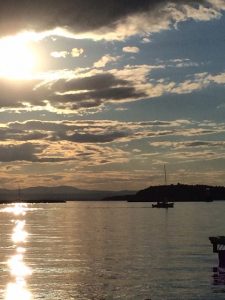 As I sit on a boat on Lake Champlain in Northern Vermont, I can smell the earthy fragrance of the lake and hear the lapping of the gentle waves upon the hull. Why did this give me a sense of calm?
As I sit on a boat on Lake Champlain in Northern Vermont, I can smell the earthy fragrance of the lake and hear the lapping of the gentle waves upon the hull. Why did this give me a sense of calm?
Perhaps it was because it reminded me of many summers visiting my sister and brother-in-law at their “camp” on Methuen Pond outside of Boston. That brought my thoughts to those times as a medical student when I would take a tiny Sunfish sailboat out on the Charles River that separates Boston from Cambridge, Massachusetts. Digging deeper into my memory, I remembered the summers when my sister and I used to visit our best friend’s family cottage at Lac Nominingue – one hundred and twenty-five miles north of Montreal, or when we would visit my aunt and uncle and cousins at their rented cottage on Trout Lake, only sixty miles north of Montreal.
I remembered swimming in the bracing water and running back to the house shivering, in Nominingue to stand in front of the warm fireplace; at Trout Lake to have a lunch of macaroni and cheese, which my aunt had at the ready for us teeth-chattering children. With our parents we sometimes would drive south from Montreal to Vermont, New Hampshire, or Upstate New York, and stay in little pine paneled cottages next to running brooks, where we would step from stone to stone. So, water for me was all these memories rolled into one – memories of vacation, family, friends, and love.
 Now, since moving to Tucson, Arizona in 2012, I spend summers with my partner, telecommuting from Vermont. On weekends, from our boat on Lake Champlain, I look out over the ever-changing water towards the hills and mountains – Vermont’s Green Mountains, and New York’s Adirondacks. It is a meditation.
Now, since moving to Tucson, Arizona in 2012, I spend summers with my partner, telecommuting from Vermont. On weekends, from our boat on Lake Champlain, I look out over the ever-changing water towards the hills and mountains – Vermont’s Green Mountains, and New York’s Adirondacks. It is a meditation.
 When floating on six trillion gallons of water – Lake Champlain is the “sixth Great Lake” – it is hard to imagine that there are places on earth where there is none. In Tucson, I have become acutely aware of lack of water, and carefully monitor my use of it. We rejoice when the Rillito River, most of the year a dry riverbed, occasionally fills with water after a storm. People line up to photograph the roiling waters charging past.
When floating on six trillion gallons of water – Lake Champlain is the “sixth Great Lake” – it is hard to imagine that there are places on earth where there is none. In Tucson, I have become acutely aware of lack of water, and carefully monitor my use of it. We rejoice when the Rillito River, most of the year a dry riverbed, occasionally fills with water after a storm. People line up to photograph the roiling waters charging past.
When the monsoon rains come to Tucson in summer, or the quieter steady rains in early spring, the desert bursts into bloom – subtle by Vermont standards, but dramatic against the backdrop of rocks and scrub. When it rains all day or all night in Vermont, I appreciate all the more the greenery that follows and the profusion of wildflowers in the roadside and fields.
While the desert holds many charms, how awful it would be without water all the time. The contrast makes me all the more conscious of how important it is to preserve this most precious of all our commodities.
Lasting Art, Part 1
I felt surreal, floating, like watching myself in a play at the Susan Sebastian Foundation capstone event, celebrating placement of original artwork in virtually every patient room in every hospital in Vermont. It was hard to wrap my mind around the idea that my book, Healing Spaces had helped to inspire this accomplishment.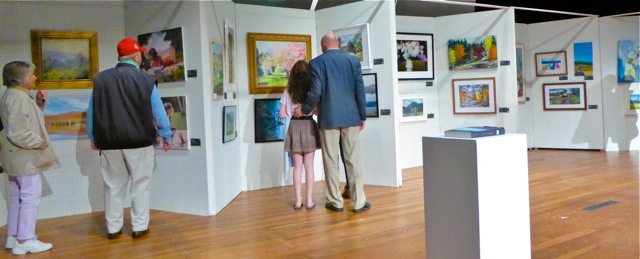
I had been invited to speak at the art show and reception at the Southern Vermont Art Center, celebrating the purchase of the last paintings for the last hospital – the Southwestern Vermont Heath Center (Click HERE to watch the video). The SVHC event organizer, Ashley Jowett picked me up at the lovely old Inn in Manchester where we were staying, and drove me to the venue. It was a rainy day and as we wound our way up the mountain road to the Center, I glimpsed statues of all sorts in the field at the base of the hill and scattered through the dripping woods: a larger-than-life shiny metal horse, oddly shaped metal tubes, a twisted black metal wire sculpture of fighting wolves. 
We arrived at a clearing in the woods where several frame buildings stood in a circle, and Ashley dropped me off at the center one. Lining the walls of the hallway and on the brightly lit stage in the barn-like auditorium, were the one hundred pieces of original art that had been selected by a jury of artists, healthcare and hospital professionals. Fifty-four will be placed in rooms at SVHC, and the rest were available for sale to benefit the Art Center – a win-win for the patients, their families and the artists of Vermont.
I was in awe. When you write a book you never know the impact it will have – the words could just disappear into the ether. But here was a project that took my words and put them into practice across a whole state. Completely mind-blowing!
To be continued…
